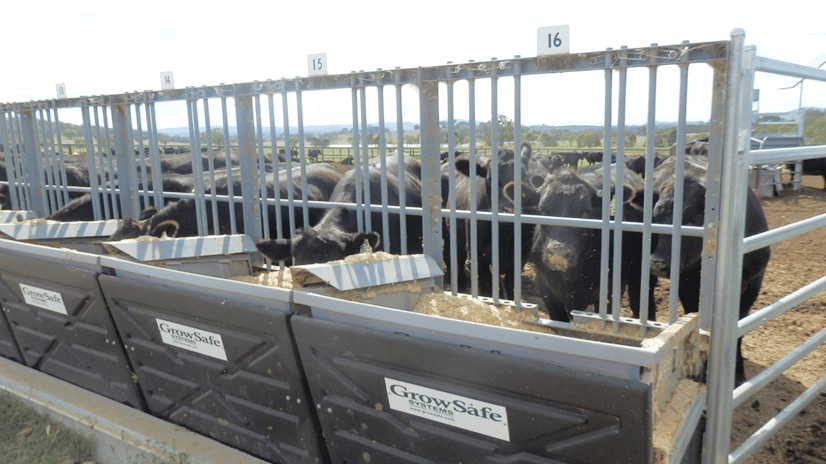
Feeders in action in a 16-stand GrowSafe NFI testing station
THIS week, we start a two-part series examining the topic of net feed intake, and whether it is worth applying selection pressure for in seedstock animals.
There are different measures of feed efficiency in cattle, with different commercial applications. Gross Feed Efficiency (GFE) is the amount of feed required for each kilogram of weight gained, and is the measure most commonly used by the lotfeeding industry, as it reflects the cost of feeding animals per kilogram weightgain.
It can be measured for individual animals when the required intake measurement is available but in commercial feedlots it is calculated as average feed conversion efficiency across a pen of animals.
This measure of feed efficiency favours later larger mature size animals, as in general larger mature animals grow faster and have better gross feed efficiency than earlier maturity animals.
If used as a selection criteria in a breeding herd it would select for larger mature size cows.
The largest feed cost for a breeding/finishing operation is the feed maintenance cost of the cow herd, so there is a strong economic incentive to keep the mature size of cows down to reduce their feed maintenance requirements.
Net Feed Intake (NFI) also known as Residual Feed Intake (RFI) is the amount of feed consumed by an animal which is above or below the amount of feed that the animal is expected to consume, based on its maintenance and weightgain, using scientifically based feed intake tables.
The most widely used equipment to measure daily feed intake of individual animals for the calculation of GFE or NFI is Grow-Safe units, which read an electronic tag on each animal as it enters and leaves the feed station stall, and records the amount of feed consumed at each visit to the feed station for up to 15 animals in a pen.
The weightgain of the animal is measured as the difference between the starting weight of an animal over a 72 day period, after a 28 day introductory period.
The most favourable animals for NFI are those that consume less feed than expected based on their maintenance and growth requirements and the least favourable animals are those that consume more than expected.
Feedlot versus pasture results
The expectation has been that those animals which have below average feed requirements (negative NFI) when fed on a roughage diet in a feedlot environment will also be the most efficient animals in a grazing situation. If this were the case, then there would be strong economic incentives to select cattle for NFI, because the breeding herd would require less feed for maintenance and milk provided to their calves.
However the technology available to this point to measure the consumption of pasture on a daily basis has not been sufficiently accurate to demonstrate the relationship between NFI measured on a roughage ration and the amount of pasture consumed in a grazing situation.
This may change in the not too distant future, as new technology developed by CSIRO which can measure the number of “bites” taken by an animal when grazing is currently being trialled in a number of commercial Angus herds in a Meat & Livestock Australia funded project.
To make this trait a little more complicated, research by the Animal Genetics and Breeding Unit (AGBU) showed some years ago that the measure of NFI on animals post-weaning on a roughage diet was a different (but related) trait to the measure of NFI in older animals on a high energy feedlot ration.
Hence two Estimated Breeding Values are calculated depending on the feeding conditions. They are NFI-P, for young animals on roughage diets, and NFI-F, for older animals consuming a high energy feedlot ration.
Three breeds, Angus, Hereford and Wagyu are currently conducting Net Feed Intake measurements on significant numbers of steers (progeny testing) under high energy feedlot conditions.
All steers which are produced in the Angus Sire Benchmarking Project (ASBP) are being tested for NFI at the Tullimba Research Feedlot near Armidale, NSW. With approximately 350 steers in each cohort this amounts to a total of 2100 steers tested in the first six cohorts.
Herefords Australia has also tested more than 1000 steer progeny for NFI through the breed’s BIN Project*.
The Australian Wagyu Association is also undertaking extensive measurements of NFI at the Kerwee Feedlot at Jondaryan, Qld. The fifth cohort of 180 animals each has now been completed, totalling about 900 measured animals.
In total, the three breeds have now collected NFI data on about 4000 animals.
- Some of the results from testing of Angus, Wagyu and Hereford cattle and their commercial use will be covered in part two of this report next week.
* Reference to Herefords program omitted from the original version of this article – since added. Editor

It would be helpful if Paul Butler would explain why he thinks RFI is not the answer to greater efficiency.
Feed conversion!!!
RFI is not the answer to greater efficiency.